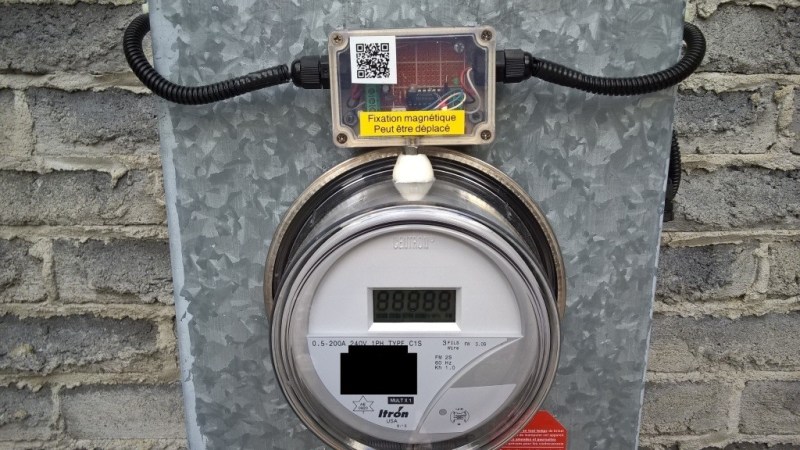Hackers love to monitor things. Whether it’s the outside temperature or the energy used to take a shower, building a sensor and displaying a real-time graph of the data is hacker heaven. But the most interesting graphs comes from monitoring overall power use, and that’s where this optically coupled smart-meter monitor comes in.
[Michel]’s meter reader is pretty straightforward. His smart wattmeter is equipped with an IR LED that pips for every watt-hour consumed, so optical coupling was a natural approach. The pulse itself is only 10 ms wide, so he built a pulse stretcher to condition the pulse for a PIC microcontroller. The PIC also reads the outside temperature with a DS18B20 and feeds everything to the central power monitor, with an LCD display and a classic Simpson meter to display current power usage. The central monitor sends the power and temperature data to Thingspeak, along with data from [Michel]’s wood-stove monitor and a yet-to-be-implemented water heater monitor.
[Michel] is building out an impressive suite of energy and environmental monitors for his Quebec base of operations. We’re looking forward to seeing how he monitors that water heater, and to see what other ideas he comes up with.
















I have the same meter – might be a project I’ll try.
Exactly what I was thinking. Even 10us shouldn’t be much trouble for a microcontroller if done properly.
My exact thought. It depend on how the microcontroller is programmed. I couldn’t find any program on the page but I may suspect that 10us can be tricky if you don’t use an interrupt.
It is handled with an interrupt so 10ms is not a big deal. I made it wider just to see the pulse and because de cable is long.
Nice design. I do get the impression that the kW hours differ on the analog vs. digital panel. Help us understand this? Is it average vs. Peak? instantaneous vs. peak? Is there a lag?
The scale on the meter shows “divide by 2”. I could have made another scale but the original was nice so I kept it.
10ms is a very long pulse for a microcontroller. Could do away with the pulse stretcher if the code uses interrupts or even just poll the interrupt registers.
It is handled with an interrupt so 10ms is not a big deal. I made it wider just to see the pulse and because de cable is long.
Would it be easier to code the MCU to blink an LED when it detects the 10uS pulse? Pulse-stretch in software, not hardware?
Peace …
Just read the hackaday.io page and see that your sensor is remote, so a long cable and 10uS could get eaten quicker than 10mS.
Unfortunate that the meter on my swelling is not the type shown. Not sure if it has an IR LED on it.
Thanks for the show. :)
Hmm. That was supposed to be a reply to tekkieneet’s post. Not sure what happened there.
Bonus that the wire sleeves look like bull horns.
If anyone is wondering, the QR code is a redirection to
https://thingspeak.com/channels/20713/
I didn’t expect my phone to be able to read it on the screen due to the resolution but it did.
Qr is pretty robust. I often see desktop websites with qr codes to scan with the phone. Qr codes can be still read with one marker missing, scratches, and few cm scan distance.Some qr apps use back and white filter to boost recognition.
If you want to print out a new meter scale that shows KWH instead of that “divide by two” you can download and print one up using the Meter Basic software for free from here: http://www.tonnesoftware.com/meter2.html
I used it to make three new scales for my meter clock. (Faces are at https://github.com/AlanKilian/AnalogClock)
Very interesting. Thank you for the links!
Just wondering why the meter would have an IR LED that pulses every kW. I could understand it being a visible RED LED because you could see it pulse, but since we can’t see IR, I am baffled.
Likely for automated testing during manufacture
A visible LED still isn’t human-readable – there’s no benefit. If it were up to me, I’d choose IR LEDs so the utility doesn’t get all sorts of frightened/angry kooks calling about being surveilled or seeing “trouble indicators”.
Almost all US smart meters have a big red blinking light on them when they transmit their Zigbee mesh data. the neighborhood looks like it is filled with action movie bombs.
Fortunately, our US smart meter is IR. Our neighborhood would certainly have rallied against visible LEDs.
Mine is IR too. I have never seen one that was visible in my travels around my state.
If you have that meter on your house look closelly on the lower right corner on the meter’s diplay you’ll notice 3 small rectangles. They change state at every W/h.
Now he just needs an optical water-meter reader, and a door sensor on his mailbox!
A way to read all the registers via the IR port on the meter would be an awesome addition.
For the record all the digital meters I’ve seen in AUS have red blinking LEDs. I’m not aware of any issues with that.
Careful with attaching things to the meter panel magnetically. Utility companies like to claim that putting strong magnets near your panel can confuse the meter and by putting anything magnetic next to the meter is equivalent to stealing power. Cue angry dude on youtube cause his utility company stole his magnets: https://www.youtube.com/watch?v=OgKQihUEFA0
Cue local evening news stations shaming the utility for seizing man’s equipment without authority, interfering with his patriotic hope of managing and conserving his own power to save $$, and to point out that newfangled “smart meters” are immune to the strong magnetic fields (we’re talking a big coil and lots of juice) which the old silver-disc meters were affected by.